Iran’s opposition to foreign powers interfering in its domestic affairs reflect its historical urge for sovereignty, it stems from the fact that a nation, with such a rich history and culture, a nation that had been invaded and exploited by the Russian and by the British during the last two centuries, needs and deserves a place amongst the developed nations.
And so, Iran is “cursed” by its own Geostrategic importance and rich natural resources (Patrikarakos, 2012).
During the 20th century, and apart from the 1979 Khomeini’s Islamic Revolution, Iran went through three military coups.
Overthrowing Reza Shah (1941)
One of them happened when Reza Shah was ‘peacefully’ overthrown on September 16th 1941, put in an ‘unmarked car’ and was dubbed ex-Shah now after the British had decided that his time in power had come to an end. The next day, at 4:30 in the afternoon, his 21-year-old son Mohamed Reza Pahlavi emerged as the new Shah of Iran. His reign will last till 1979.
Why did they overthrown him? Well, Britain and The Soviet Union, launched Operation Countenance on August 25th 1941, after feeling that Reza Shah’s official position of neutrality is suspicious and after watching Iran and Germany get ‘uncomfortably close’ during the 1930s. The Operation would consist of invading Iran in order to secure Iran’s oilfields and supply lines, after Germany launched Operation Barbarossa, began invading USSR, breaking the 1939 Molotov-Ribbentrop Non-Aggression Pact between them (Patrikarakos, 2012).
Ending The Qajar Dynasty (1925)
You go back twenty years earlier, in 1925 to be accurate, and you discover that the same British that removed Reza Shah from power are the ones who made him The Shah after they ended a century-old Qajar Dynasty.
1953 CIA’s Coup D’etat: Overthrowing Mohamed Mossadeq

The same pattern seems to continue, but this time with Prime Minister Mohamed Mossadeq—who had been democratically elected—was overthrown by a CIA American-British engineered coup d’état, as part of Operation Ajax. Mossadeq’s popularity grew to a level that became concerning to the Shah. Few months after being overthrown, the nationalist leader, was “led into his court trial”. During his reign as a prime minister, he stood for his country and, he was known for his “honesty and integrity, strongly opposing foreign meddling in Iran at the time when most Iranians perceived many of their economic and political hardships as originating from such influence”(Petherick, 2006 ). Eventually, he was sentenced due death, and hadn’t it been for his age— later, the sentence was commuted—he would’ve faced the same end as that of Saddam Hussein, forty years earlier.
And that’s how, in a period spanning 28 years, Iran had had THREE military coups, from 1925 to 1953.